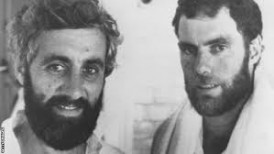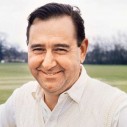Bristling with Intent: some Bearded Wonders
David Taylor |
With the approach of ‘Movember’ I thought it might be an opportune time to take a look at the history of facial hair in cricket, and in particular the beard, or the ‘full set’ as I believe it’s known in the Royal Navy. One would expect cricketers, by and large, to follow fashion, and the beard is something which goes in and (more often) out of fashion. This year there were some impressive beards on the county circuit – early in the season I saw Hampshire’s David Tomlinson sporting a voluminous growth and a wide-brimmed sunhat, looking rather like a miniature WG Grace – and we also had ‘the Beard that’s feared’ courtesy of Moeen Ali and his somewhat unexpected success against India’s batsmen.
But as I indicated the beard is not always in vogue, and besides this year’s hipsters there have probably been only two extended periods in cricket history when it was popular – what might be loosely termed the last third of the 19th century, and again in the late 1960s and early ’70s. Cricket in the sixties, contrary to everything else going on at the time, was as dull as could be imagined, and was probably too innately conservative to embrace the ‘flower power’ look, although I remember a few long-haired county cricketers in the mid-1970s, not to be confused with the eighties mullets sported by Warwickshire’s Paul Smith and, famously, Ian Botham.
So let us begin with a look at some of the 19th century beardies, starting with the most famous of them all.
WG Grace was probably the most famous man in England in the last forty years of the century, with the possible exception of four-times elected Prime Minister William Gladstone. The Grand Old Man, as he came to be known, has been the subject of several biographies, of which Simon Rae’s ‘WG Grace: A Life’ from 1998 (the 150th anniversary of his birth) is particularly recommended. He was the first to make a hundred first-class centuries, and in the years when domestic cricket received at least as much, if not more attention, than international contests, his prodigious feats often dominated the sporting headlines. Much has been written about his so-called ‘shamateurism’ (he was an amateur who made more money from the game than any professional of his time) and his bending of the Laws, but his status as the father of the modern game can surely not be seriously challenged. Next October, on the 100th anniversary of his death, I intend to make a trip to his grave at Beckenham in south-east London, and I suspect I won’t be the only one to do so. WG seems to have had a beard from early adulthood – it’s hard to track down a picture of him without one – and famously, the Australian Ernie Jones managed to send a bouncer through it, to the GOM’s consternation.
On the other side in those early Ashes contests could be found Dave Gregory, Jack Blackham and George Bonnor, all of the hirsute fraternity. Gregory in fact never played for the Ashes, as his brief Test career ended before the famous obituary appeared, but he has his place in history as Australia’s first Test captain, and of course as one of a famous cricket family – his nephews Syd and Jack would go on to achieve far more for their country. Blackham also appeared in that first Test match at Melbourne in March 1877, but his career went on for more than 17 years – he’s acknowledged as the first great wicket-keeper in international cricket. Fred Spofforth supposedly refused to play n that inaugural match because his New South Wales team-mate Billy Murdoch wasn’t keeping wicket (both made their debuts a fortnight later), but ‘the Demon’ was surely misguided there, as Victoria’s Blackham went on to perform sterling service for his country. Bonnor was one of the first big hitters to play at international level – his record credits him with ten sixes in 30 innings, but at that time the ball had to be hit out of the ground, so we can be sure that by later criteria he would have had many more. He it was who hit the enormous skied catch to Fred Grace in the first Test played in England, at the Oval in 1880.
Among England’s players in that first series were Alfred Shaw of Nottinghamshire and Sussex, slow-medium and one of the most accurate bowlers of his or any time, whose figures in that first innings were 55.3-34-51-3 (four-ball overs), and James Southerton, who has the melancholy distinction of being the first Test cricketer to die (in 1880) and who, while not strictly a beardie, boasted an impressive set of mutton-chop whiskers that wouldn’t be seen again until Godfrey Evans’ later years.
Time passed and fashions changed; the Edwardians favoured trim and sometimes waxed moustaches, and after the First World War the clean-shaven look was the way forward (it’s not hard to imagine how Douglas Jardine would have responded had one of his men turned up with even a couple of days’ growth). Pogonophobia – the fear or mistrust of the bearded man – has held sway in much of the world ever since; no American President has sported facial hair since William H Taft who held office from 1909 to 1913. Notwithstanding the occasional Sikh player from India, we have to go to the 1970s to find a revival – by which time the BBC’s very own Bearded Wonder, Bill Frindall, was a fixture at Test Match Special (Frindall was heard but not seen of course, which may be how he got away with it).
Then, around 1975, the worm turned. Firstly in the West Indies, Andy Roberts with his neat goatee, the proud Rastafarian Vivian Richards, and ‘Whispering Death’ Michael Holding. In Australia the hair got longer and the moustaches droopier. And when England travelled Down Under for the rather hastily arranged three-Test series which saw the restoration of the Packer players, both sides were led by bearded men, as we can see above. Mike Brearley only kept his for a short time – he was aware that he was seen as a rather gentle, even effeminate, figure in Australia and grew a thick beard as a way of cultivating a more macho image. Consequently, crowds there took to calling him ‘the Ayatollah.’
By 1981 the beard in cricket had reached its apogee. Although Brearley had succumbed to the razor by the time of his recall, Graham Gooch, Mike Gatting, Peter Willey, Mike Hendrick and Ian Botham – in the course of his finest hour – all sported beards, as did Ray Bright and Martin Kent of Australia. Chris Old followed a year or two later. Botham can be seen now in the mind’s eye – forever bearded and bare-headed, crashing fours off Lillee or Alderman or charging in to turn the course of a match.
Since then the razor – and perhaps the various players’ wives – has held sway. Botham and Holding are generally clean-shaven in the Sky commentary box these days, although Botham sometimes turns up sporting a stubbly look that seems to be the permanent appearance of many modern players. Of course runs, wickets and results are paramount, but it does seem to me that sportsmen representing their country need not always look so scruffy. Never mind Jardine, I can’t imagine Ray Illingworth would have stood for it either. Beards seen on modern players tend to be worn for religious reasons, and will be featured in the team of Bearded Wonders I thought I might finish this piece with. I’ve excluded those players such as Botham and Daniel Vettori, who only wore theirs for a limited time. As for the 12th man, there’s only one obvious candidate for me: Graeme Beard of Australia!
WG Grace (captain)
Saeed Anwar
Vivian Richards
Hashim Amla
Mohammad Yousuf
George Bonnor
Wasim Raja
Jack Blackham
Andy Roberts
Michael Holding
Monty Panesar






Leave a comment